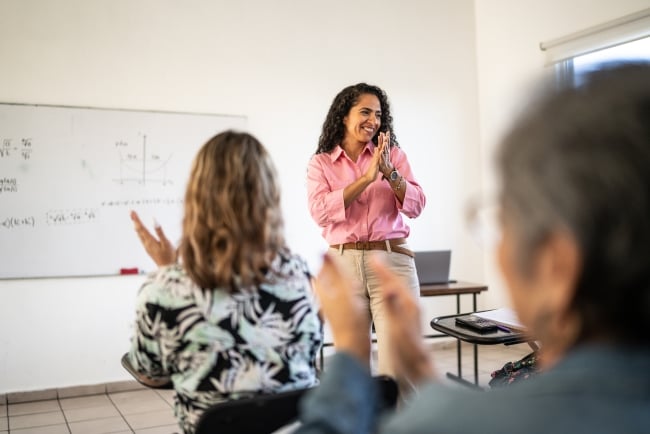You have /5 articles left.
Sign up for a free account or log in.

In-class team-building activities can create a more relaxed learning environment, giving students space to open up and share with one another or the professor.
FG Trade Latin/E+/Getty Images
Professors are key to a student’s academic success and retention through their teaching, course content and assessment strategies, but students say interpersonal relationships also play a role in their learning.
In a 2023 Student Voice survey from Inside Higher Ed and College Pulse, one-third of student respondents reported believing that having a professor take an interest in getting to know them would promote their academic success.
Natalie Ortega-Moran, assistant teaching professor of Spanish at Villanova University, started her career in K-12 schools, which has guided some of her work in higher education in establishing connections with and among students.
“An academic classroom where there are no connections or established relationships with students, is just that, an academic classroom,” Ortega-Moran says.
The most difficult aspect for a professor looking to establish connections with students can be finding common ground, as students come from many different backgrounds. Course material can be the bridge, as the instructor shares their connections to the information and solicit students to do the same.
“Even students with little or nothing to offer in way of personal connections have the opportunity to connect with others in a forum where they are invited to do otherwise,” Ortega-Moran says.
Ortega-Moran shares six strategies she implements in her Spanish courses to make authentic connection an element of her pedagogy.
- Introductions. At the start of the term, Ortega-Moran shares about herself, including her family, her interests and her academic journey. “Opening up and sharing one’s story allows students to see the sometimes-vulnerable experiences of their professor,” Ortega-Moran shares. “For some students, this establishes a sense of trust in an academic environment when they might feel more comfortable also sharing their experiences.”
- Written assignments. Students write about themselves in weekly short paragraphs, using learned content to talk—in Spanish—about their family, their likes and dislikes, their hometowns and future plans. This allows learners to practice their grammar and writing while also giving Ortega-Moran a glimpse of their personal lives.
- Active learning. In-class activities including critical thinking and team building can create a more relaxed learning environment, which gives students space to open up and share with one another or the professor. Plus, half of students nationally want their professors to experiment with different teaching styles, according to Student Voice data.
- Flexible availability. The Student Voice survey also found 22 percent of students want their instructor to be more accessible outside of class hours, something Ortega-Moran says can build trust between professor and student. “Making oneself available outside of office hours demonstrates a willingness to help students succeed,” she explains.
- Office hours. During her office hours, Ortega-Moran will address academic content, but she also attempts to get to know students better and establish connections.
- Campus involvement. Attending student activities on campus can help reinforce the humanness of the professor to students and show support outside of the classroom. Ortega-Moran has received invitations to athletic events and student presentations because of her connections, and attending gives her an opportunity to demonstrate care.
Do you have an academic success tip that might help others encourage student success? Tell us about it.




